Ed Gorman's Blog, page 90
May 23, 2014
what dead men say AVAILABLE AGAIN ON AMAZON
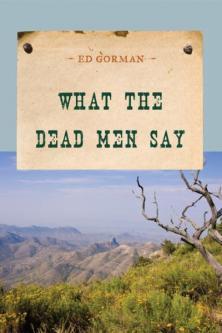
Ed here: Excellent reviews except for a savage PW.
"For it is my belief no man ever understands quite his own artful dodges to escape from the grim shadow of self-knowledge." Joseph Conrad
Ray Sawhill from the much missed high brow low brow 2 Blowhards:
Ed Gorman's "What The Dead Men Say." I've long relished Ed Gorman's work as a short story writer and an anthologist; the man has done more for the cause of short fiction and miscellanies (two forms I adore) than anyone else I know of. More recently I've been a fan of his blog. But -- to my shame -- this 1990 western was the first novel of his that I've read. I'm pleased to report that I found it a knockout. From one point of view, it's merely a lean and trim genre piece. From another, it's remarkable: tough and direct, yet complex and shocking too.
Gorman doesn't violate the Western genre; he doesn't attempt to "do something with it" in the lit-fict sense either. Instead, he applies his brains and gifts to bringing the classic form and the classic elements of the form to bristling life. In other words, the novel is a morality-tale / chessgame involving archetypal characters and situations: the tenderfoot, the sherrif, the showdown, the hooker. His themes are classic too: the relationships between revenge and justice, the unpredictable yet inevitable unspooling of fate, manliness and authority.
As sonnet form seems like anything but a hindrance when it's in the hands of a fluent sonnet-writer, the Western in Gorman's hands seems like an amazingly expressive vehicle. As a piece of construction and writing, the book is terse yet canny, punctuated by rare but effective -- ie., shrewdly-judged -- verbal bursts. Gorman moves the point of view around in unshowy ways that always deepen and heighten, and he keeps injecting little psychological surprises that bump the story's tension level up a notch. The characters may be archetypes, but that doesn't keep them from bursting with persuasive and engaging life.
Gorman also provides enough earthy atmosphere, tang, and wonder for three books. Though its boots may be firmly planted in the muck, this novel makes a few quick visits to the stars. If you were ever curious about what a frontier town smelled like, you'll know by the end of "What The Dead Men Say." Though his characters are anything but thinkers, Gorman's empathy and imagination jogged my brain into contemplation of a surprising number of Larger Questions.
This blunt and methodical book about innocence, justice, and what it means to become a man delivers a real kick, as well as a generous helping of moral complexity and warm-blooded humanity. In its directness, and in its bleak yet charged impact, it reminded me of the renowned literary short stories of Raymond Carver. Me, I like Gorman's work better than Carver's. How great it is to be able to enjoy all that truth and observational juice plus a real story too.
Published on May 23, 2014 16:02
May 22, 2014
CINEMA RETRO SPECIAL REPORT- "VIVA SABATA!": REFLECTIONS ON THE LEE VAN CLEEF/YUL BRYNNER TRILOGY By Fred Blosser
CINEMA RETRO SPECIAL REPORT- "VIVA SABATA!": REFLECTIONS ON THE LEE VAN CLEEF/YUL BRYNNER TRILOGYBy Fred Blosser

BY FRED BLOSSEROn a windy night, a black-clad stranger rides into Daugherty City, Texas. He flips a coin to a scruffy drunk who is strapped for the price of a drink. He exposes a crooked dice game in the local saloon, where most of the townsfolk seem to be congregated.Then he departs. In the meantime, down the street, a gang of acrobatic robbers breaks into the bank and heists a safe containing $100,000 in Army payroll money. The getaway crew escapes town before a wounded trooper can raise the alarm, but out on the trail they run into the stranger, Sabata, who picks them off with a tricked-out rifle and recovers the stolen money.
Thus, in under 15 minutes of running time, Gianfranco Parolini neatly sets up the events that will drive the remaining 90 minutes of his 1969 Spaghetti Western, "Ehi amico... c'è Sabata, hai chiuso!" -- better known simply as “Sabata,” as United Artists retitled the English-dubbed version that debuted in the U.S. in 1970. The original Italian title translates to something like, “Hey, Pal, Sabata’s Here, You Lose” . . . or maybe closer to the film’s rambunctious spirit, “. . . You’re Screwed.”
Bracketing the opening credits, Parolini economically introduces most of the movie’s main characters, establishes their personalities, and through their interactions with Sabata and each other, defines the interpersonal relationships that will drive the plot.
Sabata (Lee Van Cleef), the sharp-eyed “man who knows,” as the drunk Carrincha (Pedro Sanchez) calls him, deduces that the men behind the attempted robbery are the local businessman Stengel, his partner Ferguson, and their crony Judge O’Hara (Gianni Rizzo). He approaches them and demands $10,000 in hush money. Refusing, Stengel dispatches one assassin after another to kill him. Stengel’s henchman Slim, a hulking gunman named Sharky, two hit men dressed like the Earp brothers, and a nervous killer disguised as a clergyman all try and fail. With each attempt, Sabata raises his price higher and higher.
An old acquaintance, barroom minstrel Banjo (William Berger), one of the supporting characters deftly sketched in the opening saloon scene, ambles in and out from the periphery, toting his own tricked-out weapon, a carbine hidden under his musical instrument. Sometimes he sides with Sabata for money, sometimes he works for Stengel; in any event, not to be trusted by either. He and a greedy saloon girl, Jane, have a sort of romance characterized by mutual boredom and availability. Carrincha and a mute Indian acrobat, Alley Cat (Nick Jordan), help Sabata.
Arguably, “Sabata” represented the high tide of Spaghetti Western popularity in the States in 1970, benefiting from the box-office success of Sergio Leone’s groundbreaking films and preceding the decline of the genre as it sputtered toward a slow box-office death in the mid-‘70s. Where Leone’s movies were generally panned by mainstream U.S. media on their initial release, but nevertheless attracted a small early following of more progressive critics, “Sabata” ironically met the opposite reception.
for the rest go here: http://www.cinemaretro.com/index.php?...
Published on May 22, 2014 08:15
May 21, 2014
existential ennui Westlake's Parker & Graham Greene's Raven
Ed here: I was trying to find a piece by David Thomson on Graham Greene my favorite writer when I came across this. A letter on a piece by Donald Westlake about Peter Rabe struck me as pretty cogent take on Graham Greene's Raven and Westlake's Parker. The piece on EXistential Ennui was sold but even better was this letter in Comments.
Chris said...Haven't read the essay yet, Ethan--Westlake referenced "This Gun for Hire" (he used the American title) in the third of his Sam Holt novels. Once I read Greene's novel, I knew that Parker was, to some extent, a romanticized (and vastly more effective) Raven--see, Greene was a moralist, but not much of a romantic--Stark reverses that polarity. The stories of TGFH and The Hunter unfold along quite similar lines, but to much different effect.
As to the diagnosis, Greene provides that, you might say, when he compares Raven to a mangy wolf in a cage. Remove the mange (and the harelip), add a few pounds of muscle, give him a better diet, a whole lot more self-understanding and control, and you have Parker. Parker is what Raven wishes he could be. And even so, he remains an enigma, which I agree is a primary source of his lingering appeal. And perhaps the reason they still haven't made a movie that gets him even halfway right. Raven's arguably had better luck there, even though they always edit out the harelip. And the British accent.But Nick's got me really curious to read more Rabe (just one early book so far, they're not so easy to find), to see how much Parker owes to him as well. And honestly, just for his own sake. I'm running out of Westlakes to read. :)
Published on May 21, 2014 13:57
May 20, 2014
Forgotten Books: The Evil Days by Bruno Fischer
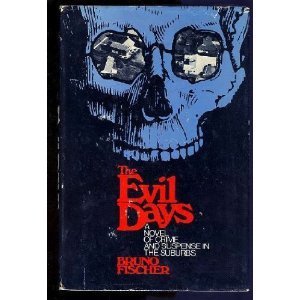
Forgotten Books: The Evil Days by Bruno FischerBruno Fischer had one of those careers you can't have any more. There's no market for any of it. He started out as editor and writer for a Socialist newspaper, shifted to terror pulps when the newspaper started failing, became a successful and respected hardcover mystery novelist in the Forties and early Fifties, and finally turned to Gold Medal originals when the pb boom began. His GMs sold in the millions. His House of Flesh is for me in the top ten of all GMs.
Then for reasons only God and Gary Lovisi understand, Fischer gave up writing and became an editor for Colliers books. But he had one more book in him and it turned out to be the finest of his long career.
Fischer shared with Howard Fast (Fast when he was writing mysteries under his pen names) a grim interest in the way unfulfilling jobs grind us down, leave us soulless. Maybe this was a reflection of his years on the Socialist newspaper. The soullessness features prominently in The Evil Days because it is narrated by a suburban husband who trains to work each day to labor as an editor in a publishing company where he is considered expendable. Worse, his wife constantly reminds him (and not unfairly) that they don't have enough money to pay their bills or find any of the pleasures they knew in the early years of their marriage. Fischer makes you feel the husband's helplessness and the wife's anger and despair.
The A plot concerns the wife finding jewels and refusing to turn them in. A familiar trope, yes, but Fischer makes it work because of the anger and dismay the husband feels when he sees how his wife has turned into a thief. But ultimately he goes along with her. Just when you think you can scope out the rest of the story yourself, Fischer goes all Guy de Maupassant on us. Is the wife having an affair? Did she murder her lover? Is any of this connected to the jewels? What the hell is really going on here?
Sometimes we forget how well the traditional mystery can deal with the social problems of an era and the real lives of real people. The hopelessness and despair of these characters was right for their time of the inflation-dazed Seventies. But it's just as compelling now as it was then when you look at the unemployment numbers and the calm reassurances by those who claim to know that the worst is over.
All this wrapped in one hell of a good tale by a wily old master.
Published on May 20, 2014 14:34
May 19, 2014
John Pete Schmidt, JDM friend and collaborator, talks about an incident involving John D
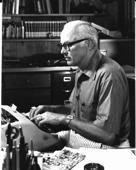
This is from Steve Scott's magnificent website The Trap of Solid Gold:
The only time I ever saw John lose his temper was in defense of [his wife] Dorothy. We were covering the Coppolino trial in Naples [Florida], and at the trial was an actor by the name of Brad Dexter. His claim to fame was that he had appeared in a movie with Frank Sinatra calledNever So Few [sic]. In the process of this movie, when they were filming -- it was a World War II movie -- they were storming the beaches. Sinatra and Brad Dexter and all the actors were disembarking from the LST, and Sinatra happened to fall into a sink hole and was about to drown. Dexter was a much larger man, and he reached over and pulled him out by the collar, saved his life. It was a matter of weeks that Dexter was a producer in Hollywood.
He happened to show up at the Coppolino trial in Naples because he was producing a movie called The Lawyer, based loosely on the Sam Shepherd case. That eventually evolved into a TV series calledPetrocelli.
Anyway, during one of the breaks in the trial, John and Dorothy and myself, along with other reporters, were gathered around the coffee bar. Dexter and F. Lee Bailey had come back from a three or four martini lunch. Dexter was using some really foul language, and John cautioned him not to do that. Not only was Dorothy there, but Theo Wilson, a [female] reporter for the New York Daily News among other women [were] standing around. He persisted, and you could just see John starting to turn red. Finally he challenged the guy. Doc Quade, a reporter for the United Press International and myself had to physically restrain John from going after Brad Dexter because he could not tolerate that kind of language or that disrespect. Dexter backed down; he left and he never came back -- he didn't appear in the courtroom after that. In fact, I never saw him again after that.
Dorothy was a very important, a very important part of his life. After every session of the trial, we would go back to the apartment. We stayed at the Edgewater Beach Hotel. Dorothy was always there with cherry tomatoes and cashew nuts, and all these cheeses and snacks; and we would sit and rehash the whole day's trial. She would give her input and she was part of the whole creative process. She was a wonderful, wonderful person...
John was very high on Jack Lord [portraying Travis McGee in the movies]. Jack Lord in his early career played in a very short-lived TV show called Stoney Burke. John and Dorothy were both fans of the show, and we thought that Jack Lord had expressed an interest in playing Travis McGee. I remember John telling me he had all the moves. He had the look of a sailor. He would probably be good for the part, and then Lord... started appearing in Hawaii Five-O. He was still interested in Travis McGee, but Dorothy watched his performance and she finally said, "John, all he does is act with his teeth!" And that was the end of Travis. Jack Lord, he lost his chance to play Travis McGee. She was a wonderful person; John was a wonderful man. I was fortunate in knowing them when I was in my early twenties, and... he was a very fatherly figure.
-- Journalist John Pete Schmidt, JDM friend and collaborator, reminiscing at the Sixth JDM Conference (November 1996) in Sarasota, Florida. A transcription of the panel discussion appeared in the 59th issue of the JDM Bibliophile. Schmidt worked with MacDonald on his 1968 Coppolino book No Deadly Drug.POSTED BY STEVE SCOTT AT 2:22 AM 2 COMMENTS:
LABELS: JDM REFERENCES IN NON-FICTION
Published on May 19, 2014 11:53
May 18, 2014
Ari Marmell, author of Hot Lead, Cold Iron
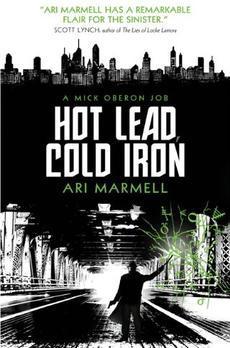
Ari Marmell, author of Hot Lead, Cold Iron-this is an excerpt from the site My Bookish Ways, one you should put on you regular list) For the entire interview go here: http://www.mybookishways.com/2014/05/...
Let me note that Hot Lead, Cold Iron is the finest urban fantasy detective novel of the past few years. Both elements work equally and Marmell gives us an exciting read that is not without an incisive look at the present day and the heart of the genre itself.
From My Bookish Ways:
.
Have you always wanted to be a writer? Will you tell us a little about yourself and your background? I’ve always been a storyteller of some sort. It took the form of role-playing games and idle scribblings throughout childhood. I decided I wanted to make writing my vocation in my sophomore year of college. As college sometimes feels like it was so long ago that at least one of my professors was quite possibly a velociraptor, I suppose that qualifies as “always.”My background is… not especially interesting, really. Born in New York, grew up in Houston, TX, now live in Austin, also TX. Spent most of my school career studying Dungeons & Dragons and fantasy novels, which may have prepared for me what I do now, but didn’t do my grades a whole lot of good. Degree in creative writing, married, have a cat, and very fortunate that I’ve had some success with the writing, because I’m utterly unequipped to do anything else.
Why do you think readers will root for Mick Oberon, and what did you enjoy most about writing his character? I think they’ll like–or at least sympathize with–him. He’s a very human character in many ways, despite being not human at all. I think readers will understand him, his motivations, why he does what he does (even if he grumbles about doing it).Plus, you know, bad-ass fey with a magic wand, facing down enemies you really don’t want to see win.fortunate that I’ve had some success with the writing, because I’m utterly unequipped to do anything else.
P
Published on May 18, 2014 13:53
May 17, 2014
Livia J. Washburn; Crime Wave Andre DeToth
Prairie Rose Publications: PRP New Release -- Mending Fences By Livia J Washburn...
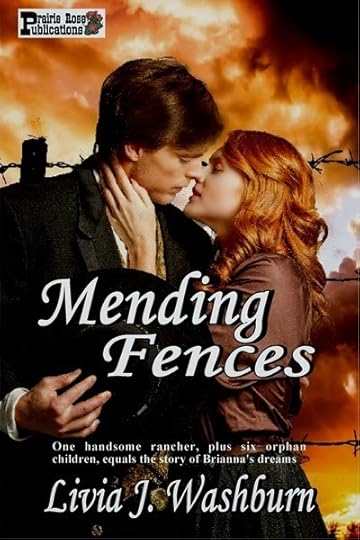 Prairie Rose Publications: PRP New Release -- Mending Fences By Livia J Washb...: Dime novelist Brianna Stark finds more than she expected in the small frontier town of Zephyr, Texas: not only a ready-made family in th...
Prairie Rose Publications: PRP New Release -- Mending Fences By Livia J Washb...: Dime novelist Brianna Stark finds more than she expected in the small frontier town of Zephyr, Texas: not only a ready-made family in th...Livia will be giving away a digital copy of MENDING FENCES to one lucky commenter today at the Prairie Rose Publication blog! Be sure to leave your contact information in your comment--it may be your lucky day! If you just can't wait to see if you won, here are the links where you can find MENDING FENCES in print and digital formats. Amazon Trade Paperback Amazon Kindle B&N Nook Smashwords
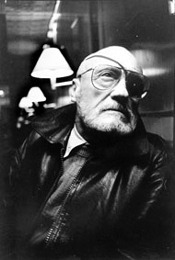
CRIME WAVE directed by Andre DeToth
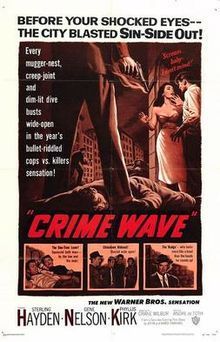
Ed here: This is one of my favorite B movies,a masterpiece of tension and psychology. Sterling Hayden is amazing but then so is Gene Nelson. Much of it was shot on location in early 50s L.A. and is fascinating to see. I watched it again last week and then Googled DeToth to see if I could find him talking about this film. This is an excerpt from a long reprint from Senses of Cinema (originally appeared in Film Noir Reader).http://sensesofcinema.com/2003/25/de_...
ADT: Yes. I got this script for Crime Wave which was quite interesting. But again they wanted Humphrey Bogart…and Ava Gardner. Or if not her, somebody like her, a star. This was all wrong. And for the cop, I needed somebody that walked the line between enforcing the law and breaking the law, that had enough strength to survive in either sphere, but not completely tied up in knots inside, someone who has a warm spot inside.AS: That wasn’t Bogart?ADT: I thought that Sterling Hayden in every way would be a better fit. He had a certain rumpled dignity. He wasn’t bigger than life like Bogart. When I wrote the story to The Gunfighter (Henry King, 1950), I thought at the time, they will probably only consider two people: John Wayne, who was big and stupid, or Gary Cooper, who had quiet dignity. How different would that have been from what they got with [Gregory] Peck? Better? I don’t think so.With Bogart or someone like that, I had 35 days to make the picture. It’s not about film noir, I know, but I think I told you before the story about making Springfield Rifle (1952) at Warners. I wanted to shoot in Lone Pine. They had an attitude: this is Warner Bros. and Lone Pine is a B-picture location. I flew my plane from Mexico to Colorado brought back ten albums of location pictures—with names on the back so they couldn’t see them—and had Jack Warner and the producer pick what they thought was best. And, of course, they picked Lone Pine. That’s how the mind works at the big studios.When I went to Jack [Warner]‘s office to talk about Crime Wave, he screamed, “What the hell are you thinking of? I offered you Bogart and Ava Gardner, the biggest names. You don’t want them?” I said, “No, thank you.” “All right, then,” he was through with me now: “Go ahead, Tex, and make the Goddamned picture with nobodies. Cut your own throat. But in that case, you’ll have to shoot it in 15 days. Go on, get out.” I was happy. I won. And I made the picture in 14 days.AS: With the cast you wanted.ADT: With the cast I wanted. You know, I never made any of these pictures to get reviews or make the studio happy. I made the pictures I wanted to make. It’s only in the last ten or 15 years that anybody has taken any notice of my pictures. Which I appreciate. But back then, I didn’t go to see my pictures in theaters. I was on to the next projects. I didn’t keep posters on the walls. My kids bought the posters in this room for me.I think there is a reason that I never went in for pictures that cost money. Once you made your first picture and came in on schedule and on budget, they left you alone. From then on, nobody bothered me, nobody looked at rushes, nobody knew what the hell I was doing. After you brought in two or three pictures, you had that freedom. And for me, that meant more than another thirty thousand dollars in my salary or another two or three hundred thousand in the budget. Most of that would have gone to bigger name actors anyway. Perhaps it was my conceit, but I felt that I was creating the picture, so even if you did not like what I had done, if you thought it was shit, it was still my shit.AS: So you preferred working in B-budget films?ADT: Yes. At that time, I had worked in a range of budgets from two hundred or two hundred fifty thousand dollars up to six or seven hundred thousand; but no more. Why would I want to do a “million dollar picture”? I didn’t need a million headaches. With the lower budgets, most of the time, I was left completely alone.AS: Crime Wave has a lot of night location work for a 14- or even 15-day schedule.ADT: Yes, we shot most of it a night with the slower speed film of that time. But we knew what we were doing, how to light it quickly. And I never thought we needed more time. It’s like a painter staring at an empty canvas, I saw the picture and how much time I would need before I started. On everything I did, I could see what I expected to be on the screen before we started to make the picture. I really did not need more than 15 days.AS: How did you pick your Los Angeles locations in both Crime Wave and Pitfall?ADT: Actually I picked a lot of locations after talking with the local police department. Who better to tell you about what type of people live in which neighborhoods? That’s how I decided on where the house would be inPitfall. On Crime Wave, I actually asked the police which physical lay-out would make a bank the easiest to rob.The real is the simplest and the best. Why build sets or imagine locations to fit some sketches you did, I always laugh at people when they start to work with sketches. That’s not how to have a picture in your mind. When you can find a real place to hear real dialogue, isn’t that enough?
Published on May 17, 2014 12:35
May 16, 2014
Pro-File Brendan Dubois FATAL HARBOR
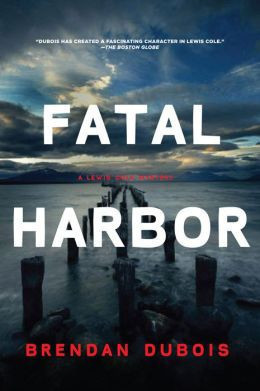
Tell us about your current novel/collection.
My 16th novel, FATAL HARBOR, has just been released by new publisher, Pegasus Books, who have been a dream to work with. It’s the eighth novel in my Lewis Cole mystery series, and I’m both pleased and yet a bit horrified to note that this is the 20th anniversary of my first novel, the debut work --- DEAD SAND --- in my Cole series.
FATAL HARBOR picks up after the end of the previous Cole novel, DEADLY COVE, where Lewis’ best friend, Detective Sergeant Diane Woods, had been beaten nearly to death and left in a coma. In FATAL HARBOR, Lewis is working hard to find the person who nearly killed his best friend, despite so very many obstacles. This book is different in that it’s not a mystery novel, per se. It’s more of a thriller/revenge work, where right from page one, Lewis is on a mission of revenge, and nothing --- setbacks, attacks, a deeply personal loss and betrayal --- will hold him back.
In some ways, I think of this as being the best of my Cole novels, with a fast-moving plot and an insight to just how far someone will get to seek justice.
2. Can you give a sense of what you're working on now?
Ah, so many projects, so little time. A month ago, I finished the first draft of the next Lewis Cole novel, BLOOD FOAM. It’s currently with my first readers, and I hope to get it out to my publisher in a few weeks.
I’m also gobsmacked to find myself in a position where I have three other novels in the hands of three separate publishers, in various stages of review, including a stand-alone crime thriller, my first true science fiction novel, and a futuristic thriller that I modestly think is the best thing I’ve ever done.
I also have about seven or eight short stories out making the proverbial rounds, and I’ve totally embraced the e-book revolution. I’ve gotten the rights back to some of my previous novels, have also done collections of my short fiction, and are selling all via Kindle, Nook and Smashwods.
I also wrote a self-published book on the strange yet exciting experience of being a “Jeopardy!” gameshow champion, and am working to get that --- along with other works --- converted to an audiobook format.
Besides that, nothing much else is going on.
3. What is the greatest pleasure of a writing career?
To have the best job in the world, in which I set my own hours and pace, and get paid for storytelling, and to meet fans and writers from all over the world.
4. What is the greatest DISpleasure?
Editors who take months to make a decision. Agents who act as gatekeepers and editorial reviewers, overlooking their primary job to assist writers in their careers. Royalty statements that make no sense. And pay scales, for the most part, that haven’t even come close to the realities of today’s economy.
5. If you have one piece of advice for the publishing world, what is it?
Try to reduce the insane pressure to find “the next big writer” and focus more on us poor mid-list folks. Sniff-sniff.
6. Are there two or three forgotten mystery writers you'd like to see in print again?
I’m still stunned that John D. MacDonald is now practically ignored. Amazing. When I broke into the mystery field in the 1980’s, he was the proverbial Goliath in the field, and I spent an exhilarating year or so, reading all of the Travis McGee series. Now… almost entirely forgotten. Then there’s Tony Kenrick, who wrote a bunch of humorous and twisty thrillers back in the 1970’s, and Edwin Corley, who wrote a number of stunning books in the 1960’s and 1970’s, including “Seige,” about an African-American army of revolution that seizes the island of Manhattan, and “The Jesus Factor,” a breakneck thriller about the possibility that nuclear weapons don’t work, have never worked, and that the atomic bombings of Hiroshima and Nagasaki were an elaborate hoax.
7. Tell us about selling your first novel. Most writers never forget that moment.
I was working at my corporate communications job at utility in New Hampshire when my agent called in the summer of 1991, saying that my first Lewis Cole novel, DEAD SAND (and my fourth novel in actuality) had been purchased by Pocket Books I had to admit tears came to my eyes; ever since I was twelve, I wanted to be an author, and now, 20 years later, my dream had come true.
Published on May 16, 2014 09:28
May 15, 2014
Dead Man's Hand edited by John Joseph Adams
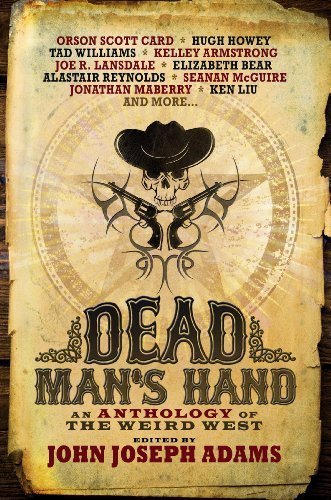
This is an excerpt of an interview from the fantastic website SF Signal one of the truly must-read sites for pop culture fans of all kinds. Serious interviews coupled with
breaking news coupled with reviews and commentary.
Go here: http://www.sfsignal.com/
Kristin Centorcelli | Wednesday, May 14th, 2014 at 2:00 pm Comments (2)
 John Joseph Adams
John Joseph Adams
KC: There are so many awesome names in this anthology! How the heck do you choose what stories to include?JJA: The process for Dead Man’s Hand was more or less the same as for any other theme anthology: Basically I try to think about what authors that I know and like could do something interesting with the theme in question.In some cases, I look for folks who I know have written on the subject before. For instance, I recruited Joe R. Lansdale because he’s a legend in this subgenre, having written not only the Jonah Hex comic for an influential run, but also the genre-defining novel Dead in the West. I asked Mike Resnick to write something because he has a current weird western series ongoing from Pyr Books. I invited Alan Dean Foster because of his series character Mad Amos Malone, which he’s been writing about off and on for many years now. I brought Fred Van Lente on board because he wrote the original comic the movie Cowboys & Aliens was based on. There were several other cases along these lines as well, where there were authors I was a fan of who I knew had written weird westerns, so I reached out to try to get them to participate.Other times, there was just something about the author’s work that I made it seem like a safe bet they’d be able to turn in something interesting on this topic. Sometimes it’s just a shot in the dark, and you just don’t know until you ask. A few folks I asked just flat out said “I don’t like westerns” (which is fair enough!). But plenty said yes. There were a few I really hoped to get that I couldn’t, but I can’t really complain about the table of contents–as you say, it’s quite a star-studded affair.By the time the book was done, I realized that not a single person had written about Wild Bill Hickok, which in retrospect really surprises me. But given the anthology is named after the legendary gunslinger, I figured it would behoove me to try to add a story on that topic. Luckily I didn’t have to look far to find someone: When I was grousing about the lack of Hickok stories over dinner, my wife, Christie Yant, said she’d take a shot at it, and so we ended up with the eponymous story that closes the book, “Dead Man’s Hand.”Otherwise, it’s the usual editorial method: Did I like the story? Does it fit the theme? etc. For Dead Man’s Hand, I actually had a couple of stories I loved that I couldn’t include because I didn’t feel like they sufficiently fit into the western genre.
for the rest of the piece go here:
http://www.sfsignal.com/archives/2014...
Published on May 15, 2014 10:01
May 14, 2014
Ross Thomas, The Procane Chronicle
Ross Thomas, The Procane Chronicle
One of life’s true pleasures is reading a Ross Thomas novel. He never lets you down when you re-read him, either.
I’ve now read The Procane Chronicle for the third or fourth time, and even though I now know all the amazing surprises Thomas blesses his readers with, the prose alone is as much fun as the story. The only writer living today who can even come close to the grace and nimbleness of Thomas is Lawrence Block. Block knows from sentences.
In this one, Phillip St. Ives is dragooned by poverty as usual to act as a go-between when a blackmailer sets a price. St. Ives is hired to make sure that both sides keep their promise. The stake this time is a possible Mafia war.
As always, Thomas gives us a radiantly cynical take on Washington, D. C. and all who do business there. Though thirty years have past since original publication, Procane depicts a nation’s capitol no different from the one we know today. St. Ives is lied to and betrayed by everything on two legs, even – or especially – those fine looking female legs.
For me, Thomas was one of the two or three best crime writers of the last century. He brought to each book a witty and brutal intelligence that exposed all of us as less than we’d want to be.
Many if not most of Ross Thomas are available now on Otto Penzler's fine Mysterious e book site.
One of life’s true pleasures is reading a Ross Thomas novel. He never lets you down when you re-read him, either.
I’ve now read The Procane Chronicle for the third or fourth time, and even though I now know all the amazing surprises Thomas blesses his readers with, the prose alone is as much fun as the story. The only writer living today who can even come close to the grace and nimbleness of Thomas is Lawrence Block. Block knows from sentences.
In this one, Phillip St. Ives is dragooned by poverty as usual to act as a go-between when a blackmailer sets a price. St. Ives is hired to make sure that both sides keep their promise. The stake this time is a possible Mafia war.
As always, Thomas gives us a radiantly cynical take on Washington, D. C. and all who do business there. Though thirty years have past since original publication, Procane depicts a nation’s capitol no different from the one we know today. St. Ives is lied to and betrayed by everything on two legs, even – or especially – those fine looking female legs.
For me, Thomas was one of the two or three best crime writers of the last century. He brought to each book a witty and brutal intelligence that exposed all of us as less than we’d want to be.
Many if not most of Ross Thomas are available now on Otto Penzler's fine Mysterious e book site.
Published on May 14, 2014 18:52
Ed Gorman's Blog
- Ed Gorman's profile
- 118 followers
Ed Gorman isn't a Goodreads Author
(yet),
but they
do have a blog,
so here are some recent posts imported from
their feed.



